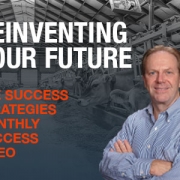When Will You Go Upstream?
So often, we get caught up in the throes of responding to various crises in our business. You know, feeling like you are always “on call,” just waiting to put out the next fire… We basically are, as Author Dan Heath suggests, “…downstream, handling one problem after another, but we never make our way upstream to fix the systems that caused the problem.” So, why do we act in this manner?
I have two suggestions. First, you do not have to act in this very manner. Second, I’ve worked with my Clients to avoid this problem. I’ve taught them to respond, when needed, but, more significantly, start exploring (as Dan Heath describes it) “Upstream,” in effect where the problem started.
Let me provide you with a real-life example. My Client was a distributor of various fruits & vegetables. They would contract with growers, and then market these items after they were “re-packed” into their containers. Historically, they were fairly profitable, but their labor costs were getting out of control… Imagine that!
Regardless of what type of business you are in, you should consider the similarities of their situation with that of your company. Whether you measure your Revenue, Expenses and Profitability on a per box or per bag basis as they did or some other measure, this same thinking is still applicable.
If we know our costs, as we did in this case, and we understand the historical levels of rejected units under normal conditions, we can predict, with some degree of certainty, our expected results & profitability. Remember, if you can measure it, you can understand it. If you can understand it, you can control it, and if you can control it, you can improve it! Looking at these early in the process is what Dan Heath calls “Pre-game measures.”
The next step Heath suggests is to “Align incentives.” With this mind, we reinvented the labor/pay structure completely to include incentives for these workers to produce positive results. Since we had already modeled their Revenue, Production & Costs, we could simultaneously incentivize the workers and boost results on both their productivity and the profitability of the company.
As a direct result of going “Upstream,” several positive things happened. First, the workers involved made more money by being incentivized (And, trust me when I say: not everyone bought into this concept. They left for what they assumed were greener pastures elsewhere…). Next, the increase in productivity levels was astounding, partly as a result of the remaining employees “buy-in” to the new process. Finally, the profitability of the company jumped dramatically from a seven-figure loss to a very healthy profit, as we had predicted!
This is just an example of what can happen when we go “Upstream,” and rather than just “putting out fires,” in this case on the Labor front, actually determine the true source of the problem and then work to preemptively correct it. In stark contrast to their old program, which wasn’t working for either the Company or its Employees, this new incentivized program worked better for both of them. My question for you is this:
“Where, when and how will you go Upstream in your business?”
If you will continually do this, I guarantee that you will continue to expand your future opportunities and profitability results! I urge you to please join me in making the changes we need to in order to succeed and prosper! As we move forward with my Next Level Thinking™ blogs, I’ll continue to focus on the benefits of “Upstream” thinking from Author Dan Heath. If I can assist you in any way on this process, please reach out at john@success-strategies.com or at 209-988-8960.










Leave a Reply
Want to join the discussion?Feel free to contribute!